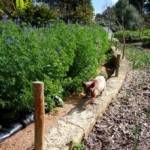
The Garden Bed Walls Project at Arohanui
We are fortunate enough to have been offered a grant by WWOOF NZ to support the development of our garden bed walls project. We are Michael and Jocelyn McKenzie and we live in the Kaipara, Te Tai Tokerau. Our project together started just over six years ago when we moved onto our 10 acre property. The first thing we did (even before building a whare) was to start cultivating the soil, double-digging clay heavy soil to begin the process of introducing fertility to the earth in which we can now grow nutrient dense food. Six years on our gardens are super productive.
We’ve always worked with what we’ve had around us, or have access to. In the beginning of this journey, Michael was a café owner, and so access to biodegradable bags filled with used coffee grinds was plentiful. We found that by piling these on top of one another we had instant garden bed sides, which were soft to kneel on and when they split, the worms multiplied ferociously, as they love old coffee grinds.
Six years on we have come to appreciate some of the benefits of living with clay-heavy soil… earth building! Michael, who is a baker, built a wood-fired pizza oven from the soil beneath its foundations, and of course, we have applied similar techniques for experimenting with garden bed walls. These prototypes have provided the ability to create garden ‘islands’ which reduce the presence of weeds and snails, and also help to reduce moisture seepage from the soil during the dry summer months. In order to see these walls really last the distance, we must still experiment with the ideal ratios of the different materials.
The earth walls are made of clay from our property, aggregate, straw (for tensile strength) and a very small amount of concrete, as the walls are constantly exposed to the weather. Not only are these walls super functional for soil health, but they provide great places to sit and enjoy the garden, they’re aesthetically pleasing, and they provide a cat walk for Pixie! We would only recommend utilising this method if you are on clay soil, as clay is super heavy to move around!
So, one of our many jobs over the next couple of busy months is to transform our garden bed walls to the earth wall alternative. We’ll keep you posted with progress. We’d like to extend a huge thank you to WWOOF NZ for supporting this project.
Final update December 2015
Our garden bed wall project has reached completion, and we’d like to say a huge thank you to all of the wwoofers who have helped us reach our goal of finishing by December. There has been lots of muddy fun, and lots of physical work. We’ve had people as young as three years old help us create our reinforced cob walls around our garden beds.
Michael, with Luc and Guillhem during a day in the mud
As the weather has warmed up, and some of the walls have dried, we’ve found that the ratios we’ve been working with have allowed for a nice finish once dry, with very little cracking (clay/aggregate equal parts, 20% cement, and enough straw as the tensile strength to bind it all together).
Working on tarpaulins means the materials can be mixed more easily
So now it’s on to the many other summer jobs for us, including tending our garden with all its new bed surrounds. We’d like to say thank you again to the team at WWOOF NZ for the financial support in this project, and for all the work you do in making the WWOOF programme happen here.
Tomatoes and Garlic beds with their new surrounds
KAKARIKI Project Herb Garden
Our french woofers have helped us building the deck in the med. herb garden, beds are ready to be planted, a fence is tidying up the edge and hedges surrounding the garden will accommodate beneficial bugs.
The finished product, except the planting of all the herbs, as some can only be done at a certain time of the year.












